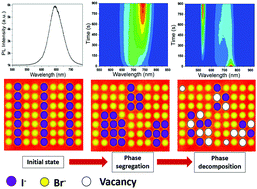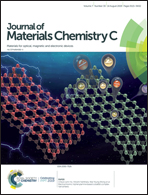Light induced degradation in mixed-halide perovskites†
Abstract
Metal-halide perovskites have emerged as one of the most promising semiconductor materials for photovoltaic and other optoelectronic applications. Recently, mixed halide hybrid perovskites where I− is partly substituted by Br− have driven a paradigm shift in perovskite solar cells, combining tunability of absorption onset with high performance. However, poor long-term device stability has been limiting their practical application and the mechanisms of degradation have not been fully understood. In this work, we study light induced degradation in mixed halide perovskite CH3NH3PbI3−xBrx. Although it is well-known that such perovskites undergo a reversible light-induced phase segregation, the subsequent degradation process under continued, and in particular high intensity laser irradiation has not been systematically studied. By utilizing in situ laser excited photoluminescence spectroscopy it is shown that such mixed halide perovskites degrade via light-induced degradation of the I-rich domain after this initial phase segregation. Significantly, the oxygen sensitivity of the I-rich domain is identified as a key factor to inducing this irreversible decomposition as supported by in situ Raman spectroscopy. Our work provides insight into the degradation of mixed-halide perovskites under high light intensities and direction for the development and processing of compositionally and environmentally stable perovskite materials.



 Please wait while we load your content...
Please wait while we load your content...